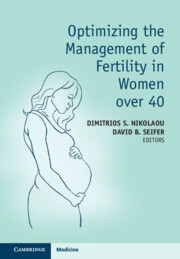Book contents
- Optimizing the Management of Fertility in Women over 40
- Optimizing the Management of Fertility in Women over 40
- Copyright page
- Dedication
- Contents
- Contributors
- Introduction
- Section 1 Demographic Trends
- Section 2 Biological Basis of Female Reproductive Aging: What Happens to the Ovaries and the Uterus as they Age?
- Section 3 Lifestyle, Environment, and Optimizing Reproduction in the 40s
- Section 4 Rethinking and Redefining “Family Planning” for the Twenty-First Century
- Chapter 4 Diagnostic Testing of Reproductive Aging
- Chapter 5 Fertility Preservation for “Social” Reasons
- Section 5 Optimal Deployment of ART beyond 40
- Section 6 Obstetric Management beyond 40
- Section 7 Children of Older Parents
- Section 8 What Are Realistic Alternatives to Conceiving with Autologous Eggs?
- Section 9 New Technologies
- Section 10 Ethics
- Index
- References
Chapter 4 - Diagnostic Testing of Reproductive Aging
from Section 4 - Rethinking and Redefining “Family Planning” for the Twenty-First Century
Published online by Cambridge University Press: 15 September 2022
- Optimizing the Management of Fertility in Women over 40
- Optimizing the Management of Fertility in Women over 40
- Copyright page
- Dedication
- Contents
- Contributors
- Introduction
- Section 1 Demographic Trends
- Section 2 Biological Basis of Female Reproductive Aging: What Happens to the Ovaries and the Uterus as they Age?
- Section 3 Lifestyle, Environment, and Optimizing Reproduction in the 40s
- Section 4 Rethinking and Redefining “Family Planning” for the Twenty-First Century
- Chapter 4 Diagnostic Testing of Reproductive Aging
- Chapter 5 Fertility Preservation for “Social” Reasons
- Section 5 Optimal Deployment of ART beyond 40
- Section 6 Obstetric Management beyond 40
- Section 7 Children of Older Parents
- Section 8 What Are Realistic Alternatives to Conceiving with Autologous Eggs?
- Section 9 New Technologies
- Section 10 Ethics
- Index
- References
Summary
Recently there has been an increase in age-related infertility, termed ‘reproductive aging’, in which both quantity and quality of oocytes decline. Various established ways to analyze oocyte quantity include assessing age, follicle stimulating hormone, antral follicle count, and anti-Mullerian hormone. Each test has strengths and weaknesses inherent to the test itself and there can be concern when the tests are discordant. Additionally, several algorithms have been proposed that assess multiple elements to predict live birth rates per transfer and most recently cumulative live birth rates per retrieval. Knowledge about fertility has been assessed in several survey-based studies. These surveys illustrate a limited understanding of the participants regarding the impact of age-related fertility decline and a lack of realistic expectations regarding the limitations of IVF or egg cryopreservation to preserve the age-related decline in fertility. Additionally, there are inconsistencies in whether women would choose to have ovarian reserve testing and whether this would alter management. Lastly, emotional response after receiving ovarian reserve testing is also highly variable. This encourages providers to have a conversation about potential ramifications of testing.
Keywords
- Type
- Chapter
- Information
- Optimizing the Management of Fertility in Women over 40 , pp. 39 - 55Publisher: Cambridge University PressPrint publication year: 2022



